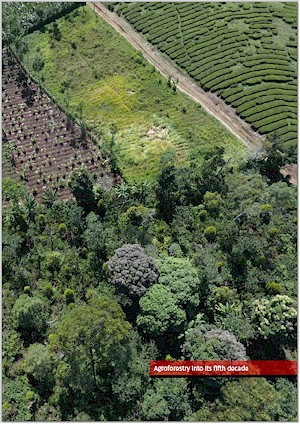| Book Chapter |
 |
|
| Title | Agroforestry into its fifth decade: local responses to global challenges and goals in the Anthropocene | | Author | Meine van Noordwijk, Lalisa A. Duguma, Sonya Dewi, Beria Leimona, Delia C. Catacutan, Betha Lusiana, Ingrid Oborn, Kurniatun Hairiah, Peter A Minang, Andree Ekadinata, Endri Martini, Ann Degrande and Ravi Prabhu | | Editors | Meine van Noordwijk | | Year | 2019 | | Book Title | Sustainable development through trees on farms: agroforestry in its fifth decade | | Pages | 395-418 | | Call Number | BC00480-19 |
|
| Abstract: |
Chapter 1 outlined the evolution of agroforestry as a concept at plot/farm, landscape and policy scales, with all three coexisting in the current links between praxis, knowledge and policy. Chapter 19 ended with the need for policies that seek and support SDG synergy in pursuit of landscapes that not only produce goods for existing markets, but also provide the services that ‘downstream’ stakeholders have in the past taken for granted but do miss when they are affected. We will here focus on the third agroforestry paradigm and the need for reinventing the interfaces between agriculture and forestry in the food, energy, water and income nexus as part of addressing the challenges of the Anthropocene, the geological era dominated by a single (our own) species.
The formulation of Millennium Development Goals, precursor to current Sustainable Development Goals (SDGs) brought the ending of poverty and the need for environmental sustainability on the same ‘goal’ level in high-level discourse. It allowed multifunctional land uses, such as agroforestry, to gain wider support. With the SDG agenda of the United Nations, agreed upon by 193 countries in September 2015, the debate has shifted from ‘willingness’ to ‘ability to act’. Because the human brain is challenged when a list contains more than 3-5 items, there have been many attempts to group the 17 SDGs. One way (Figure 19.2) is to recognize five groups: 1) SDG 1-5 deal with multiple dimensions of poverty (food, income, health, education, gender), 2) SDG 6-9 with development infrastructure (water, energy), 3) SDG 10-12 with the fairness-efficiency balance, 4) SDG 13-15 with ecological infrastructure, and 5) SDG 16 and 17 with institutions. A further grouping sees a group of goals that articulate increased demand for resources (including food, energy, water), a group that tries to maintain the resource base and a group modifying access to resources, power and benefit distribution (including gender and youth-based distinctions beyond homogeneous household perspectives). Despite critique on the goals (“By attempting to cover all that is good and desirable in society, these targets have ended up as vague, weak, or meaningless”) and comments from the science community that were only very partially taken to heart, they are still the most legitimate attempt at global governance so far, deserving efforts to try and make it work.
|
|